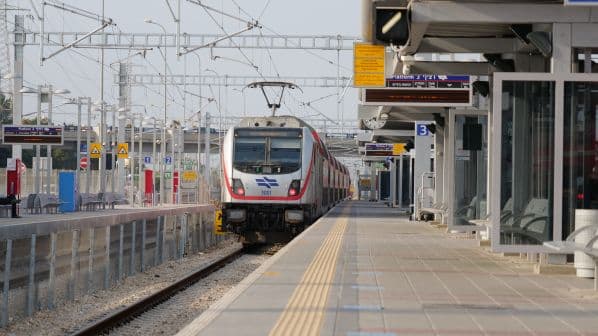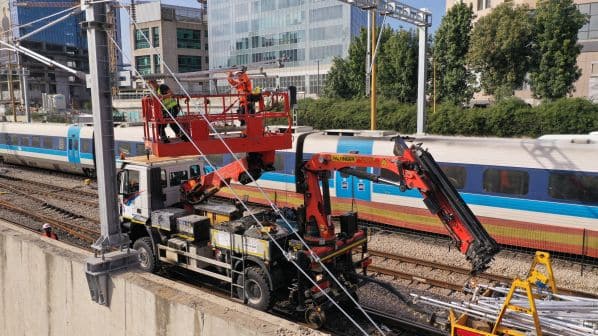AS the traffic jams in the centre of Israel worsen, Israelis are looking to other modes of transport to beat congestion. In 2019, the last year before the Covid-19 pandemic, Israel Railways (IR) carried 70 million passengers, but this is expected to increase to 100 million passengers in 2025, 200 million by 2030 and to surpass 300 million by 2040.
To cope with this increase in patronage, IR is implementing a major expansion and upgrade of its network, which includes opening new lines and deploying new rolling stock. But with space often limited in the small country, IR is also upgrading its existing infrastructure to improve capacity with the introduction of ETCS and the electrification of the network.
The project was launched in 2015 with the goal of electrifying the main trunk of the network, from Nahariya and Karmiel in the north to Beer-Sheva in the south, and including the line to Jerusalem.
Aside from the environmental benefits of switching from diesel, electrification brings additional capacity benefits, as electric trains can brake and accelerate more quickly than diesel trains and are also able to maintain higher speeds on the steep gradients of the Israeli network, while also reducing journey times. With stations sometimes only 500m to 750m apart, the mainline service is more akin to a metro service at times. However, this constant stopping and starting causes additional wear on the diesel trains, meaning they fail in service more often and require additional maintenance.
IR awarded Sociedad Española de Montajes Industriales (Semi), Spain, a design-build-maintain contract for the country’s electrification programme in 2015. The contract covered the electrification of 1080 single track-km (420 route-km) at 25kV 50Hz ac, and included design and construction of 14 substations as well as control systems.
“One of the biggest challenges was working on an active line, here you’re working either in the very short window when there is no traffic during the night and on holidays, or you are affecting the traffic for the population.”
Mr Ziv Levy, IR electrification infrastructure department manager
At the time, the total cost of the programme was estimated at Shekels 12bn ($US 3.1bn), including Shekels 2bn for infrastructure.
The first 10km section of mainline to be electrified, part of the 35km section of the new A1 link between Jerusalem Navon (formerly Hauma) station and Anava Junction, was completed in October 2017. However, progress subsequently stalled.
“One of the biggest challenges was working on an active line, because unlike a construction site, where you can work every day and can work a double shift to accelerate it, here you’re working either in the very short window when there is no traffic during the night and on holidays, or you are affecting the traffic for the population,” says IR electrification infrastructure department manager, Mr Ziv Levy.
However, this challenge was eased with the signing of a new contract between IR and Semi in 2019, after IR’s new CEO, Mr Michael (Micha) Maiksner, and representatives from the government visited the electrification works in person.

“They walked with their own feet on the Ayalon corridor and understood that you cannot squeeze a needle through there [around the trains], let alone the bulldozers and tractors that are needed to build it,” Levy says. “They understood that we need to find common ground between passenger trains and construction in order to meet the project goals.”
Under the revised electrification contract, Semi would continue to electrify all the lines but was given significantly more manpower to speed up delivery and was also allowed to recruit its own subcontractors.
Semi was also given an increased payment of Shekels 500m, to be paid depending on its ability to meet the milestones and schedules set out in the contract. A variety of scenarios were considered during the review of the plan, including reducing the scope of Semi’s contract in favour of additional contractors. However, the decision was made to continue with Semi as the lead contractor while updating the schedule to address the gaps in delivery which led to problems and delays.
The project also benefited from a subsequent change in electrification project management teams, which improved trust between IR and Semi, as well as more time for electrification work on the active railway.
The signing of the contract was followed three months later by the Covid-19 pandemic. While IR suspended passenger services to curb the spread of the virus, one silver lining was greater access for the electrification teams who continued to work on the project, resulting in significant progress.
“We revised the packages and the methodology of how to do the work, how to accelerate the work and how the packages can benefit the operation of the line and, on the other hand, provide us with the windows to work in a practical way,” Levy says. “In the 2015 contract … there was not a meeting point where we could both benefit. 2019 was the change point.”
“This is very hard to electrify because we had a lot of other infrastructure, such as water, gas and electricity, that is running nearby.”
Ziv Levy
This change proved successful, with the most challenging two-thirds of the Israeli network now completed within three years. This includes:
- the Jerusalem rapid line: Jerusalem - Ben Gurion Airport - Tel Aviv – Herzliya
- the Hasharon Ring and the western line: Herzliya - Raanna - Hod Ha Sharon - Kfar Saba - Rosh Haayin - Petach Tikva - Bney Brak - Tel Aviv - Bat Yam - Holon - Rishon Lezion Moshe Dayan - Yavne West - Ashdod Ad Halom – Ashkelon
- the suburban line and the southern coastal line: Ashkelon - Ashdod Ad Halom - Yavne East - Rehovot - Beer Yaakov - Lod - Lod Ganei Aviv - Kfar Chabad - Tel Aviv - Herzliya - Beit Yehoshua - Netanya Sapir - Netanya - Hadera West - Caesarea-Pardes Hanna - Binyamina, and
- the Modii’n - Jerusalem rapid line.
“This is the heart of the network,” explains IR spokesman, Mr Matan Berkovich. “This is very hard to electrify because we had a lot of other infrastructure, such as water, gas and electricity, that is running nearby and we added to the cost of the project because when we are electrifying a railway line, we have to stop the passenger trains.”
Work is now underway to electrify the extremities of the network, including the northern coastal line from Binyamina north to Haifa. The newly-opened Western Negev line, which runs from Ashkelon via Sderot, Netivot and Sderot to Beer Sheva, has also been included in the project.
IR’s policy is to electrify or lay the groundwork for electrification of all new-build construction projects.
“We are preparing all the mast bases to allow it to be electrified quickly from scratch,” Levy says. “Also, in terms of the height of structures like bridges or tunnels, we are ready for it.”
Practical challenges
As well as the procedural and contractual challenges that needed to be addressed to accelerate project implementation, IR and Semi faced practical challenges due to the narrow corridors through which railways have been built in Israel.
The Ayalon Line through Tel Aviv has between three and four tracks squeezed in on the west by the Ayalon highway, and on the east by a canal carrying the Ayalon river. This meant there was no space to install the concrete foundations for the catenary masts. Instead, IR and Semi developed a method of building the foundations into the supporting walls of the canal and highway, which had to be reinforced with steel and concrete to support the weight of the catenary.
“We needed to have our machinery working on the tracks, so every night we take a track possession to put the machine on the track,” Levy explains.
The electrification team also worked closely with the contractors installing ERTMS on the Israeli network, with work coordinated for civil works such as digging trenches for cabling.
Israel’s ERTMS network project is split into three elements. Alstom is delivering onboard equipment for 192 trains, with an option to equip an additional 34 trains under a contract awarded in December 2018. Thales is delivering trackside infrastructure, while Nokia and Motorola are installing GSM-R across the network under a Shekels 350m contract signed in November 2017. The partners will also maintain the GSM-R network under a 20-year contract.
IR plans to gradually introduce ETCS across its network, with the signalling system set to increase capacity on the Ayalon Line from 10 to 13 trains per hour. The A1 Link, which shares Ayalon infrastructure through central Tel Aviv, will have four trains per hour per direction without disrupting other services. IR has completed the construction of the GSM-R network and has also completed the installation of the necessary components on the track infrastructure. The project is expected to enter operation gradually in the coming years.
“We are combining the work, most of the time they are working with us to install the trackside elements,” Levy says.
The electrification project is now due to be completed in 2025, although Levy says the installation teams are working to accelerate work where they can. Finishing the project as quickly as possible is of vital importance, as rail looks set to become the backbone of the Israeli public transport network and the railway chases its passenger targets.

